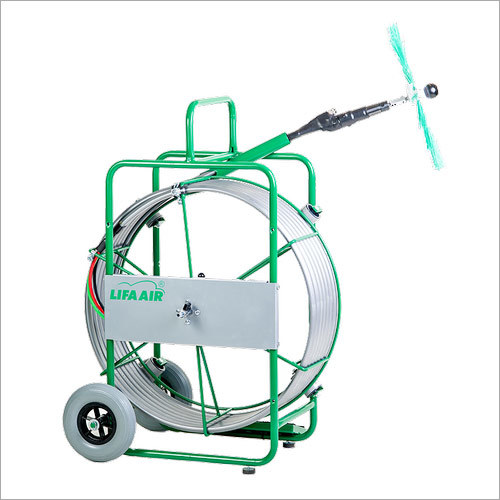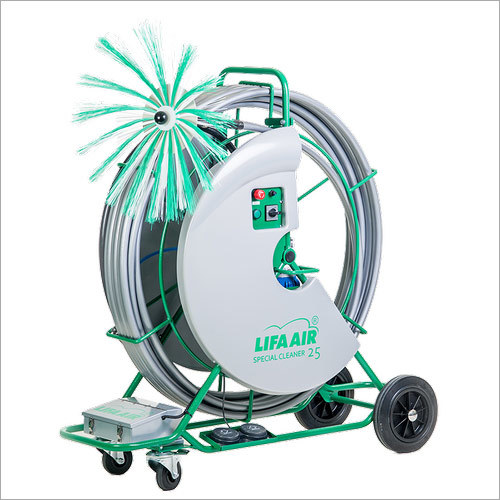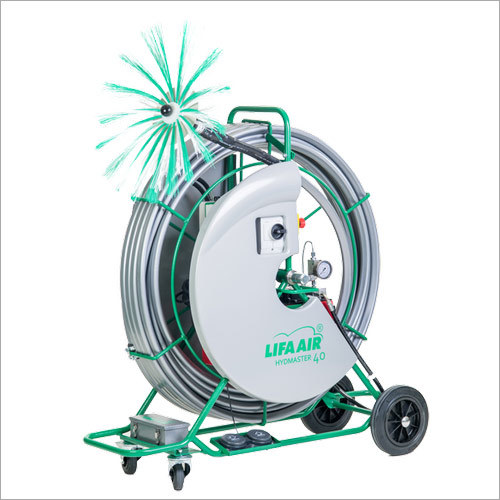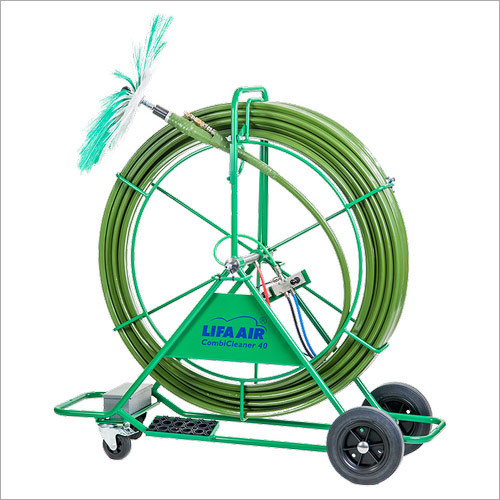Lifa Air Special Cleaner 20 - Air Duct Cleaner
1000000 INR/Unit
Product Details:
- Usage Pipe inspection, Drain and sewer inspection, Duct Inspection.
- Function Video recording, Picture capture, zoom, view content.
- Accuracy 100 %
- Product Type Air Duct Cleaning Equipment Lifa Air Special Cleaner 20
- Color Gray & Green
- Click to View more
X
Lifa Air Special Cleaner 20 - Air Duct Cleaner Price And Quantity
- 1 Unit
- 1000000 INR/Unit
Lifa Air Special Cleaner 20 - Air Duct Cleaner Product Specifications
- Pipe inspection, Drain and sewer inspection, Duct Inspection.
- Gray & Green
- Video recording, Picture capture, zoom, view content.
- Air Duct Cleaning Equipment Lifa Air Special Cleaner 20
- 100 %
Lifa Air Special Cleaner 20 - Air Duct Cleaner Trade Information
- 1000 Unit Per Day
- 1 Week
Product Description
Lifa Air Special Cleaner 20 - Air Duct Cleaner typically includes a range of tools and machinery designed to effectively clean and maintain HVAC (Heating, Ventilation, and Air Conditioning) duct systems.
Here's an overview of some common equipment used in air duct cleaning:
1. Vacuum Systems: These are powerful vacuum machines equipped with high-efficiency particulate air (HEPA) filters. They are used to create negative pressure within the duct system, effectively extracting dirt, debris, and contaminants.
2. Brush Systems: Various types of brushes are used to dislodge and agitate debris from the walls of ducts. These brushes can be manually operated or attached to motorized systems for more efficient cleaning.
3. Compressed Air Tools: Tools such as air whips and air skippers use compressed air to dislodge and push debris towards the vacuum system for extraction.
4. Access Tools: These include items like inspection cameras, mirrors, and access doors, which enable technicians to inspect and access different parts of the ductwork for thorough cleaning.
5. Chemical Cleaners: While mechanical cleaning methods are primary, some situations may call for the use of specialized chemical cleaners to break down stubborn contaminants like mold or microbial growth.
6. Sealing Materials: After cleaning, ducts may need to be sealed to prevent air leaks. Sealants and tapes designed for HVAC systems are used for this purpose.
7. Personal Protective Equipment (PPE): Safety gear such as respirators, gloves, goggles, and coveralls are essential for technicians to protect themselves from exposure to dust, mold, and other potential hazards.
8. Truck-Mounted Systems: Some companies utilize truck-mounted equipment, which houses the vacuum system and other tools in a dedicated vehicle. This setup offers increased power and mobility for large-scale duct cleaning projects.
9. Duct Inspection Equipment: Tools like remote-controlled robotic cameras or drones equipped with cameras can be used to inspect ductwork for damage, leaks, or other issues before and after cleaning.
10. Training and Certification Materials: Proper training and certification are essential for technicians performing air duct cleaning. Companies may provide educational materials and resources to ensure their technicians are knowledgeable and skilled in the proper techniques and safety protocols.
Lifa Air Special Cleaner 20 - Air Duct Cleaner Specifications:
1. Brush Connection: M12 (metric)
2. Phase: Single Phase
3. Voltage: 220V
4. Brand: LIFAair
5. Body Material: Aluminium
6. Speed: 0 to 800 Rpm
7. Length: 20 M
8. Frequency: 50 Hz
Lifa Air Special Cleaner 20 - Air Duct Cleaner Applications:
1. Residential Homes: Residential properties often require air duct cleaning to remove dust, allergens, pet dander, and other contaminants from the HVAC system. Regular cleaning helps improve indoor air quality and maintain the efficiency of the heating and cooling system.
2. Commercial Buildings: Offices, retail stores, restaurants, and other commercial establishments have larger and more complex duct systems. Regular cleaning is essential to ensure a healthy indoor environment for employees and customers and to maintain energy efficiency.
3. Industrial Facilities: Manufacturing plants, warehouses, and other industrial facilities often have specialized HVAC systems with extensive ductwork. These environments may generate additional contaminants such as fumes, particulates, or airborne chemicals, making regular cleaning crucial for worker health and safety.
4. Healthcare Facilities: Hospitals, clinics, nursing homes, and other healthcare facilities require clean indoor air to maintain patient health and prevent the spread of infections. Air duct cleaning is essential to remove contaminants and maintain a sterile environment.
5. Schools and Educational Institutions: Educational buildings can harbor dust, mold, and other allergens in their HVAC systems. Regular air duct cleaning is important to ensure a healthy learning environment for students and staff.
6. Hotels and Hospitality: Hotels, motels, resorts, and other hospitality establishments need to maintain clean indoor air to ensure guest comfort and satisfaction. Regular duct cleaning helps prevent unpleasant odors, allergen buildup, and HVAC system malfunctions.
7. Government Buildings: Government offices, courthouses, libraries, and other public buildings require clean indoor air to serve employees and visitors. Air duct cleaning helps maintain indoor air quality and ensures efficient operation of HVAC systems.
8. Data Centers: Data centers rely on precise temperature and humidity control to protect sensitive equipment. Clean air ducts are essential to prevent dust and debris from contaminating servers and other hardware, which can lead to equipment failure and downtime.
9. Food Processing Facilities: Facilities involved in food processing and manufacturing must adhere to strict hygiene standards. Clean air ducts help prevent contamination of food products and ensure compliance with food safety regulations.
10. Aircraft and Marine HVAC Systems: Air duct cleaner equipment may also be used in aircraft and marine applications to maintain the air quality and performance of HVAC systems on airplanes, ships, and other vehicles.
Lifa Air Special Cleaner 20 - Air Duct Cleaner FAQ:
Q. Why is air duct cleaning important?
Ans: Air duct cleaning is important for several reasons:
- It helps improve indoor air quality by removing dust, allergens, mold, and other contaminants from the ductwork.
- It can enhance the efficiency of HVAC systems by removing debris that may obstruct airflow.
- Regular cleaning can prolong the lifespan of HVAC equipment and reduce the risk of breakdowns.
- It may help alleviate allergy symptoms and respiratory issues for occupants of the building.
Q. How often should air ducts be cleaned?
Ans: The frequency of air duct cleaning depends on various factors, including:
- The type of building (residential, commercial, industrial, etc.).
- Environmental factors (pollution levels, proximity to construction sites, etc.).
- Occupant sensitivity to indoor air quality.
- Previous maintenance history.
In general, it's recommended to have air ducts inspected every 3 to 5 years and cleaned as needed based on the inspection results.
Q. Can I clean air ducts myself, or do I need professional services?
Ans: While there are DIY air duct cleaning kits available, it's generally recommended to hire professional services for thorough and effective cleaning. Professionals have the proper equipment, training, and expertise to safely and efficiently clean air ducts without causing damage to the HVAC system.
Q. How long does air duct cleaning take?
Ans: The time required for air duct cleaning varies depending on factors such as the size of the duct system, the level of contamination, and the complexity of the job. On average, residential duct cleaning may take 2 to 4 hours, while larger commercial or industrial projects may take longer.
Q. Is air duct cleaning messy?
Ans: Air duct cleaning can generate some dust and debris, but professional technicians use specialized equipment to minimize mess and ensure thorough cleaning. They also take precautions to protect surrounding areas and furniture during the cleaning process.
Q. How much does air duct cleaning cost?
Ans: The cost of air duct cleaning depends on factors such as the size of the duct system, the level of contamination, the location, and the service provider. Prices can vary widely, but a typical range for residential duct cleaning is $300 to $500, while commercial or industrial projects may cost more.
Q. Does air duct cleaning improve energy efficiency?
Ans: Yes, air duct cleaning can improve energy efficiency by removing debris that obstructs airflow and makes the HVAC system work harder to heat or cool the space. A clean duct system allows air to flow more freely, which can reduce energy consumption and lower utility bills.
Efficient Pipe and Duct Inspection Solution
Lifa Air Special Cleaner 20 streamlines the inspection process for pipes, drains, sewers, and ducts. With precise video and photographic capabilities, professionals can accurately identify blockages, leaks, or maintenance needs. The devices premium build, coupled with user-friendly controls, facilitates thorough assessments, supporting both routine and complex projects.
High-Accuracy Performance and Versatility
Engineered to deliver 100% accuracy, the Special Cleaner 20 ensures reliable data collection during inspections. Its versatile zoom and content view features enable detailed examination even in hard-to-access areas. Designed for use by industries across India, it enhances productivity and reduces downtime associated with manual inspection methods.
FAQs of Lifa Air Special Cleaner 20 - Air Duct Cleaner:
Q: How do I operate the Lifa Air Special Cleaner 20 for air duct inspections?
A: To operate the Lifa Air Special Cleaner 20, simply insert the device into the duct or pipe and use the control interface to begin video recording or picture capture. The zoom and content view functions help you inspect and monitor specific areas in detail for any maintenance or cleaning requirements.Q: What types of inspections can the Special Cleaner 20 be used for?
A: This device is suitable for pipe inspection, drain and sewer inspection, as well as general duct inspection. It is ideal for both preventive maintenance and diagnostic checks in industrial and commercial settings.Q: When is it recommended to use the Lifa Air Special Cleaner 20?
A: Use the Special Cleaner 20 during scheduled maintenance, to investigate suspected blockages, or whenever a detailed assessment of ducts, pipes, or sewers is required to ensure system integrity and cleanliness.Q: Where is the Lifa Air Special Cleaner 20 sourced and supported?
A: Lifa Air Special Cleaner 20 is offered by a trusted exporter, manufacturer, supplier, trader, and service provider based in India, ensuring reliable support and after-sales service domestically.Q: What is the process for capturing video and images during an inspection?
A: During inspection, users activate the video or image capture feature via the device interface. The zoom function allows for closer examination of problem areas, and all visuals are saved for later review or reporting.Q: How does using this device benefit inspection and maintenance tasks?
A: The device enhances efficiency by providing real-time video and high-definition images, making it easier to detect issues quickly. This reduces inspection time, minimizes maintenance errors, and improves overall productivity.Tell us about your requirement

Price:
Quantity
Select Unit
- 50
- 100
- 200
- 250
- 500
- 1000+
Additional detail
Mobile number
Email
 English
English Spanish
Spanish French
French German
German Italian
Italian Chinese (Simplified)
Chinese (Simplified) Japanese
Japanese Korean
Korean Arabic
Arabic Portuguese
Portuguese






 Call Me Free
Call Me Free
